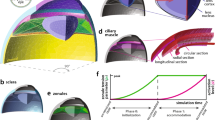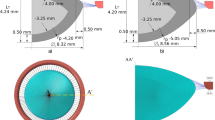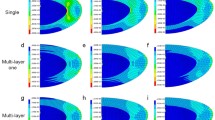Abstract
Accommodation is the ability of the eye to dynamically alter its optical power. Presbyopia is the progressive loss of this ability with age. We have developed the first pre-tensioned finite element model of accommodation and used it to address the question of whether increasing lens stiffness alone is sufficient to cause presbyopia. Intrinsic resting forces and accommodative displacement were calibrated for a 20 year-old lens’ stiffness over a 7 D optical power change. Accommodation was simulated by displacing the distal zonule attachments towards the optical axis, mimicking the movement of the ciliary body when the ciliary muscle contracts. The optical power, capsule strain, and radial zonule forces were extracted for one full cycle of accommodation. These responses were compared for lenses having elastic moduli corresponding to 14, 20, 39.5, and 62.7-year-old human lenses. Accommodative power decreased from 20 to 62.5 years of age from 7 to 2 D. This change was less than in experiments where changes in lens power go to zero around age 50. Thus, lens elasticity contributes significantly to presbyopia but is not the sole cause. Lens diameter and thickness changes were within 20 % of reported values, indicating that the present model yields a good approximation of the changes in lens shape during accommodation.











Similar content being viewed by others
References
von Helmholtz, H.: Uber die akkommodation des auges. Arch. Ophthalmol. 1, 1–74 (1855)
Koretz, J.F., Handelman, G.H.: How the human eye focuses. Sci. Am. 259, 92–99 (1988)
Heys, K.R., Cram, S.L., Truscott, R.J.W.: Massive increase in the stiffness of the human lens nucleus with age: the basis for presbyopia? Mol. Vis. 10, 956–963 (2004)
Weeber, H.A., Eckert, G., Pechhold, W., van der Heijde, Rob G.L.: Stiffness gradient in the crystalline lens. Graefes Arch. Clin. Exp. Ophthalmol. 245(9), 1357–1366 (2007)
Reilly, M.A.: A quantitative geometric mechanics lens model: insights into the mechanisms of accommodation and presbyopia. Vis. Res. 103, 20–31 (2014)
Krag, S., Andreassen, T.T.: Mechanical properties of the human lens capsule. Prog. Retin. Eye Res. 22, 749–767 (2003)
Burd, H.J., Judge, S.J., Cross, J.A.: Numerical modelling of the accommodating lens. Vis. Res. 42, 2235–2251 (2002)
Weeber, H.A., van der Heijde, Rob G.L.: On the relationship between lens stiffness and accommodative amplitude. Exp. Eye Res. 85(5), 602–607 (2007)
Anderson, H.A., Hentz, G., Glasser, A., Stuebing, K.K., Manny, R.E.: Minus-lens-stimulated accommodative amplitude decreases sigmoidally with age: a study of objectively measured accommodative amplitudes from age 3. Invest. Ophthalmol. Vis. Sci. 49(7), 2919–2926 (2008)
Wilkes, R. P.: A Whole Eye Finite Element Analysis of Accommodation. Ph.D., University of Texas at San Antonio (2014)
Urs, R., Manns, F., Ho, A., Borja, D., Amelinckx, A., Smith, J., Jain, R., Augusteyn, R., Parel, J.-M.: Shape of the isolated ex vivo human crystalline lens. Vis. Res. 49, 74–83 (2009)
Dubbelman, M., van der Heijde, G.L., Weeber, H.A.: Change in shape of the aging human crystalline lens with accommodation. Vis. Res. 45, 117–132 (2005)
Norrby, S.: The Dubbelman eye model analysed by ray tracing through aspheric surfaces. Ophthalmic Physiol. Opt. 25(2), 153–161 (2005)
Glasser, A., Campbell, M.C.: Biometric, optical and physical changes in the isolated human crystalline lens with age in relation to presbyopia. Vis. Res. 39(11), 1991–2015 (1999)
Barraquer, R.I., Michael, R., Abreu, R., Lamarca, J., Tresserra, F.: Human lens capsule thickness as a function of age and location along the sagittal lens perimeter. Invest. Ophthalmol. Vis. Sci. 47, 2053–2060 (2006)
Farnsworth, P.N., Shyne, S.E.: Anterior zonular shifts with age. Exp. Eye Res. 28(3), 291–297 (1979)
Wilde, G., Burd, H.J., Judge, S.: Shear modulus data for the human lens determined from a spinning lens test. Exp. Eye Res. 97(1), 25–48 (2012)
Fisher, R.F.: Elastic constants of the human lens capsule. J. Physiol. 201, 1–19 (1969)
He, L., Donnelly, R., William, J., Stevenson, S.B., Glasser, A.: Saccadic lens instability increases with accommodative stimulus in presbyopes. J. Vis. 10(4), 1411–1416 (2010)
Simulia.: Abaqus 6.11 Analysis User’s Manual, Dassault Systemes Simulia Corp., Providence, RI, USA (2011)
Stark, L.: Presbyopia in light of accommodation. Am J Optom Physiol Opt 65(5), 407–416 (1988)
Reilly, M.A., Hamilton, P.D., Perry, G., Ravi, N.: Comparison of the behavior of natural and refilled porcine lenses in a robotic lens stretcher. Exp. Eye Res. 88(3), 483–494 (2009)
Bharadwaj, S.R., Schor, C.M.: Acceleration characteristics of human ocular accommodation. Vis. Res. 45(1), 17–28 (2005)
Mordi, J.A., Ciuffreda, K.J.: Dynamic aspects of accommodation: age and presbyopia. Vis. Res. 44(6), 591–601 (2004)
Manns, F., Parel, J.M., Denham, D., Billotte, C., Ziebarth, N., Borja, D., Fernandez, V., Aly, M., Arrieta, E., Ho, A., Holden, B.: Optomechanical response of human and monkey lenses in a lens stretcher. Invest. Ophthalmol. Vis. Sci. 48, 3260–3268 (2007)
Burd, H.J., Judge, S.J., Cross, J.A.: Numerical modelling of the accommodating lens. Vis. Res. 42(18), 2235–2251 (2002)
Hermans, E.A., Dubbelman, M., van der Heijde, G.L., Heethaar, R.M.: Estimating the external force acting on the human eye lens during accommodation by finite element modelling. Vis. Res. 46(21), 3642–3650 (2006)
Hermans, E.A., Dubbelman, M., van der Heijde, G.L., Heethaar, R.M.: Change in the accommodative force on the lens of the human eye with age. Vis. Res. 48(1), 119–126 (2008)
Ljubimova, D., Eriksson, A., Bauer, S.: Aspects of eye accommodation evaluated by finite elements. Biomech. Model. Mechanobiol. 7(2), 139–150 (2008)
Lee, B., Litt, M., Buchsbaum, G.: Rheology of the vitreous body. Part I: viscoelasticity of human vitreous. Biorheology 29(5–6), 521–533 (1992)
Swindle, K.E., Hamilton, P.D., Ravi, N.: In situ formation of hydrogels as vitreous substitutes: viscoelastic comparison to porcine vitreous. J Biomed Mater Res A 87(3), 656–665 (2008)
Scarcelli, G., Yun, S.H.: In vivo Brillouin optical microscopy of the human eye. Opt. Express 20(8), 9197–9202 (2012)
Croft, M.A., McDonald, J.P., Katz, A., Lin, T.L., Lutjen-Drecoll, E., Kaufman, P.L.: Extralenticular and lenticular aspects of accommodation and presbyopia in human versus monkey eyes. Investig. Ophthalmol. Vis. Sci. 54(7), 5035–5048 (2013)
Augusteyn, R.C.: Growth of the lens: in vitro observations. Clin. Exp. Optom. 91(3), 226–239 (2008)
Acknowledgments
We would like to acknowledge Harry Millwater, Jeremy Mann, and the UTSA Department of Mechanical Engineering for access to and support for the high performance computer (SHAMU) and technical support for Abaqus software at UTSA.
Author information
Authors and Affiliations
Corresponding author
Ethics declarations
Conflict of Interest
The authors have no financial interest in the subject matter of this manuscript.
Rights and permissions
About this article
Cite this article
Wilkes, R.P., Reilly, M.A. A pre-tensioned finite element model of ocular accommodation and presbyopia. Int J Adv Eng Sci Appl Math 8, 25–38 (2016). https://doi.org/10.1007/s12572-015-0141-2
Published:
Issue Date:
DOI: https://doi.org/10.1007/s12572-015-0141-2




